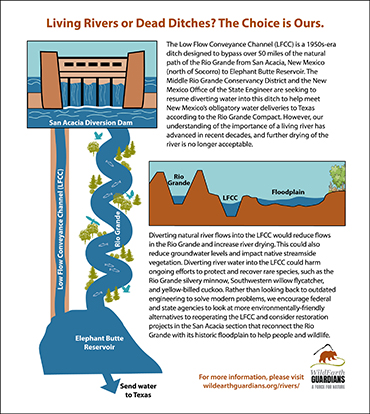Photo Credit: Tim Speer
Transforming water management to ensure a Living Rio Grande in New Mexico
Moving Beyond the Low Flow Conveyance Channel
The legacy of outdated water laws and 20th-century engineering interventions, such as dams and levees, have confined the once-mighty Rio Grande to an artificially narrow channel, separated from its natural floodplain. The impact of climate change further worsens the situation, contributing to aridification and the drying of the Rio Grande Basin. To address these challenges, a transformative approach to water management is essential to ensure a Living Rio Grande while meeting essential human water needs.
Despite the need for forward-looking holistic solutions, water managers in the Middle Rio Grande in New Mexico propose a return to outdated infrastructure to meet narrow water delivery needs. They suggest restarting diversions of natural river flows into the low flow conveyance channel, a 60-mile-long ditch running parallel to the Rio Grande, in an attempt to fast-track water to Elephant Butte Reservoir. Water managers hope that bypassing the natural river channel would help reduce New Mexico’s debt to Texas under the Rio Grande Compact. However, while it is highly uncertain whether this approach would significantly improve deliveries to Texas, the approach is likely to cause serious environmental impacts.
Diverting more water from an already diminishing Rio Grande would particularly impact the San Acacia reach, which already faces extended dry periods nearly every summer. Active diversions into the low flow conveyance channel pose a threat to the river’s ecological integrity, negatively affecting endangered species like the Rio Grande silvery minnow, yellow-billed cuckoo, and Southwest willow flycatcher.
Read what our Wild Rivers Program Director has to say about it: Low Flow Conveyance Channel – an idea that won’t die
Restoring a Wild and Flowing Rio Grande
Guardians is promoting a Living Rio that includes clean water, healthy flows, and resilient communities by:
- Actively working at the community level, building alliances, engaging in political activities, and participating formally in administrative processes to prevent the reintroduction of diversions into the Low Flow Conveyance Channel unless there are enforceable environmental protections in place to prevent river drying and to preserve aquatic and riparian habitat.
- Advocating for an alternative single-channel approach in Bureau of Reclamation’s San Acacia Reach Improvements Project, which would realign the river channel for both wildlife habitat and conveyance efficiency and remove a section of the Low Flow Conveyance Channel.
- Ensuring that federal agencies fulfill their legal responsibilities under the Endangered Species Act for the protection and recovery of the Rio Grande silvery minnow. This involves ongoing legal challenges against the existing Biological Opinion for the Middle Rio Grande.
- Engaging in political efforts to secure environmental flows by advocating for sufficient funding for New Mexico’s Strategic Water Reserve, including funding for the instream leasing of agricultural water rights.

